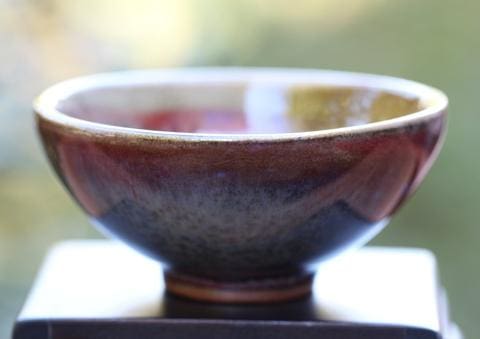
Your Guide to the Tea Cup – Part II

Have you ever noticed that some tea cups are really tiny and others are larger? Maybe you’ve wondered why some tend to be slender and tall while others are wide? While there is a degree to which beauty is in the eye of the beholder, many of these properties serve important purposes, helping you get the most out of the tea you drink. Let’s talk about it!
Shape
Tea cups comes in all sorts of shapes, from lotus flower designs to cups with handles. The most common shapes are bowls, flutes, or cylinders. When thinking about a tea cup’s function, there are broadly speaking just two characteristics that strike us as important: tall and narrow or short and wide. Any variations in shape beyond those features are mostly aesthetic.
What is the importance of a tall and narrow shape? Tall shapes make for less surface area for the tea, and this ultimately affects how long it stays warm. If you prefer your teas to be warmer for longer periods of time, then taller tea cups will help you accomplish precisely that goal. They also have the added advantage of leaving some room between the wall of the tea cup and the tea itself, which makes it a little safer to hold your cups nearer the top without burning your fingers.
By contrast, shorter and wider shaped cups will provide your tea with more surface area, which lets it cool down more quickly. In the spring and summer seasons, this style of cup is perfect for those days where you feel like sipping your tea at a cooler temperature. The trade off, of course, is that your fingers are a little closer to your tea, and so it is important to either not fill your cups too high, wait long enough for your tea to cool, or look for a cup that flares out near the rim, giving your fingers a little distance from the tea.

A nice third feature that some cups have is a foot, which is a little extra room near the bottom of the cup. Because it creates some separation between the tea and the bottom by adding some additional layers, it can make it much easier to hold, carry, or sip from your tea cups by allowing you to secure your tea cup from the bottom as well. The foot is an especially useful feature of tea bowls.
Size
Another important distinction that you might find in tea cups are the various sizes, which are generally measured in milliliters (mL) as opposed to ounces (oz).
When tea is prepared in the traditional way, known as gongfu style, it is customary to use very small tea cups along with a small teapot or gaiwan. We have a guide here for more information, but while the process can require some spare time and effort, it is unmatched in its art form, showcasing a degree of beauty, grace, refinement, and delicacy while bringing out some of the best flavors a tea has to offer. To prepare tea gongfu is to invite yourself (and others) to a meditation on tea.
Tea cups used in gongfu preparation resemble what we might think of as “tasting cups.” They are approximately anywhere from 40–100 mL, but can sometimes be a little larger or even smaller. Once the cups begin to surpass 120 mL, they begin moving into tea bowl territory.

While tea bowls are still meant for individuals and can still be used in gongfu preparation, they tend to be used more informally. There’s also something comforting and intimate about using the tea bowl. Although it lacks a handle, its larger size invites a tea drinker to grasp it with two hands as she sips, and this makes for a really nice, enjoyable tea session.
Finally, there are also tea cups that are larger than 120 mL. They are not meant for gongfu preparation, and they differ from tea bowls by being taller in size. These are best for informal tea preparations. If you plan on using a larger teapot or a stainless steel infuser, for example, then you may want to consider using these. As far as functionality goes, these kinds of tea cups are in the same family as mugs even though they usually lack handles.
What’s your favorite kind of tea cups and why?
